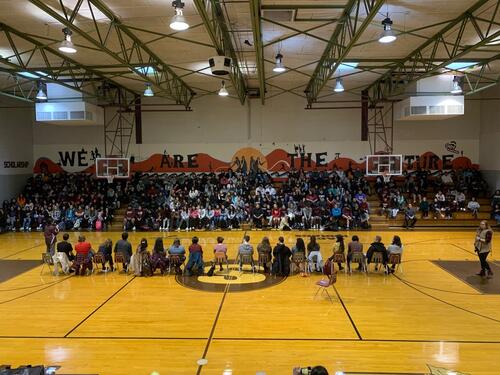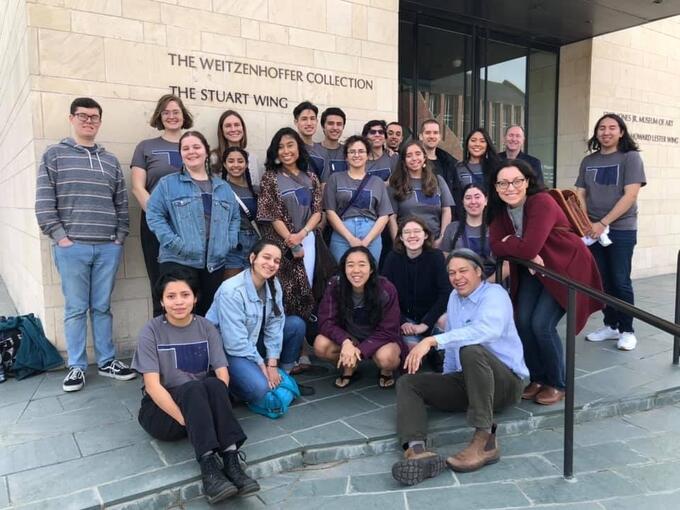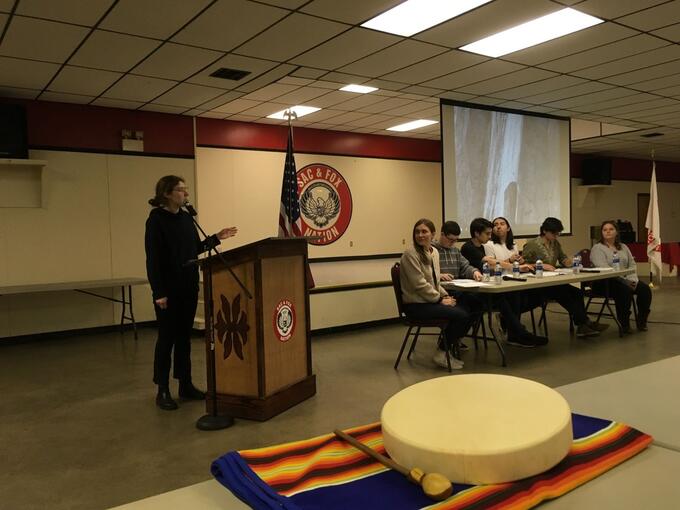YGSNA & NACC Members Reflect on “Oklahoma Sovereignty Tour”

On Sunday, March 8th, 22 members of the Yale University community arrived in Tulsa to spend the first week of their Spring Break in Oklahoma. Composed of Yale students, faculty, and staff, participants in the “Oklahoma Sovereignty Tour” experienced a four-day experiential learning program designed by Oklahomans within the Yale Native American Cultural Center. The trip sought to learn first-hand from tribal nations about tribal sovereignty and the various political, social, and economic responsibilities tribal nations hold.
The primary organizers each hold intimate knowledge of Oklahoma and its tribal nations, and this familiarity created a deeply community based experience for all participants. Many of those who joined the tour, for example, represented their own tribal nations in Oklahoma, while others were visiting Indian Territory for the first time. Funding and administrative support for the tour were provided by the Yale Indigenous Performing Arts Program, the Yale Native American Cultural Center, the Yale History Department, the Beinecke Library, and YGSNA. Many of the student participants were students in Yale College courses, including ‘Writing Tribal Histories’ and ‘Native Print Practices,’ taught by Professor Ned Blackhawk and Professor Alanna Hickey, respectively, and each helped organized aspects of the tour as did Diana Onco-Ingyadet, Assistant Director of the N.A.C.C.

Participants of the Oklahoma Sovereignty Tour outside of the Fred Jones Museum in Norman, Oklahoma.
On its first day, the tour visited the Mvskoke (Creek) Reservation. Greeted with a welcoming feast by the Fife Family, tour participants began the visit with a game of stickball before presentations by shell shakers and of Mvskoke hymns.
The following morning, the group visited Sequoyah High School, a Native American boarding school operated by the Cherokee Nation in its capital Tahlequah. They met with students and discussed future academic opportunities and college applications, visited student classes, and attended a school assembly where they participated in a question and answer. That afternoon, the group returned to the Mvskoke Reservation to learn about tribal government. Students learned about legal proceedings and the ongoing U.S. Supreme Court case McGirt v. Oklahoma. In Okmulgee, the group visited the Mvskoke Council House, established in 1878. Tours of the facility and location offered insight into Indian Territory as well as engagements with the legacies the relocation of the Mvskoke people. In a dinner conversation that evening, participants learned about an upcoming Hollywood production based on David Grann’s book, Killing of the Flower Moon, which recounts the murders of wealthy Osage people after oil deposits are found within their land. The Pipestem family discussed the interactions between their tribe and Hollywood producers, and their call for accurate representation and respect for those who were murdered.
The next day, the group visited the Gilcrease Museum where they viewed collections, talked with museum curators, and learned about ongoing efforts aimed at increasing awareness of Indigenous history and curatorial practices in the region. They also engaged in a lunch meeting about provenance, curatorial practices, and land with museum leaders. That afternoon, the group visited the Sac and Fox Reservation where they learned about Sac and Fox history, along with enjoying traditional meals and songs by the Smist family. A group of students also performed a dramatic reading of the play, “My Father’s Bones” co-written by playwright Mary Kathryn Nagle and Presidential Medal of Freedom recipient Suzan Harjo. The play examines the legal dispute haunting the Sac and Fox community over the desecration of Jim Thorpe’s remains, which are reburied in Jim Thorpe, Pennsylvania.

Anna Smist (Sac and Fox) introduces the performers of “My Father’s Bones” by Mary Kathryn Nagle.
A two-day trip to Norman brought the group to the University of Oklahoma where they met with Native American professors, students, and advisors and also learned about the university’s broad commitments to Native American Studies. They received a tour of the Fred Jones Museum of Art where they engaged in conversation about the museum’s descriptions of Indigenous people, colonial settlements, and object acquisition. The group revisited the stickball field that afternoon with students from the American Indian Student Association at OU. That evening, the group visited the Jacobson House on OU’s campus where extended members of the Norman community offered welcome songs from the drum.
The trip ended prematurely due to the COVID-19 precautions. The following days would have brought the group to the Chickasaw Nation in Sulphur, and to Oklahoma City for a visit to the Oklahoma City Bombing Memorial site and later to a feast hosted by the Freeman family and friends.
Though the tour did not encompass each tribal nation in Oklahoma (39), the group was able to experience the deep diversification of the communities in those that they visited. Conversations about tribal sovereignty were highlighted throughout each day and even at night when students stayed at predominantly tribally-owned hotels. This facet of the tour was planned partly due to ongoing disputes over the Oklahoma Tribal Gaming Compact and provided students opportunities to assess the aspects of degrees of tribal sovereignty authority in practice.
Although the trip was cut short, the events of the Oklahoma Sovereignty Tour continue to be relevant for participants. All agreed that the Oklahoma Sovereignty Tour provided an excellent opportunity for Yale students to engage with tribal communities and to examine some of the broader concerns across Indian Country. As sophomore Nolan Arkansas (Cherokee) recalls, “I was particularly impressed by the artistic and educational resources made possible to universities and the broad public by Native Nations in Indian Territory. The visit to the Gilcrease Museum was wonderful. There we engaged in critical conversations on Native art, history, sovereignty, relationships to displaced Black communities, and representation in museums. I was excited to see such a robust collection of Native art, history, and scholars.” For junior Mariko Roots, the experience proved similarly impactful, “Seeing Indigenous nations at work fundamentally has changed the way that I think about government and US geography, lessons I really hope to bring back to my own communities. It was eye-opening to see the amount of legal authority that Oklahoma indigenous nations wielded, but frustrating to hear their leaders talk about forced continued reliance on federal funding for basic needs like healthcare.”
For the tour student, staff, and faculty organizers, the tour also added new experiences and organizational activities to the fall and spring semesters. As sophomore Jay Fife, Jr. (Mvskoke) recalls about the extended planning that went into the experience, “The freedom to organize, design, and execute a journey for my peers excited & empowered me in ways that I had not experienced at Yale before.” As Professor Hickey similarly reflected, “I know of no other opportunity to sit and learn from Native nations across Indian Territory, and I’ll be forever grateful for the experience.”